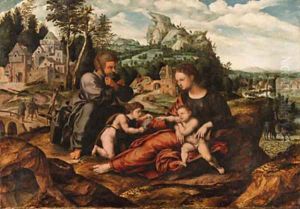An Sanders Van Hemessen Paintings
Jan Sanders van Hemessen was a prominent Flemish painter known for his contributions to the Northern Renaissance, particularly in the realm of genre and religious painting. Born in the city of Hemiksem in 1500, Van Hemessen moved to Antwerp, which was a burgeoning center of art and commerce during the 16th century. There, he became a master in the Guild of St. Luke by 1524, indicating his recognition and establishment as a professional artist. His works are characterized by their meticulous detail, vibrant color, and the incorporation of contemporary dress and settings into biblical and mythological scenes, making them accessible and relatable to the viewers of his time.
Van Hemessen is especially recognized for his innovative approach to genre painting. He is credited with being one of the first artists in the Northern Renaissance to paint scenes of everyday life, though often with a moralizing or allegorical message. His paintings often depicted the follies of youth, using satire and moral lessons as undercurrents. This was a reflection of the humanist ideals that were spreading throughout Europe, emphasizing the importance of personal virtue and the examination of personal conscience.
Another significant aspect of Van Hemessen's oeuvre is his religious paintings. He was deeply influenced by the religious turmoil of his time, including the Protestant Reformation. His works in this genre often reflect a deep introspection and a focus on inner spiritual life, aligning with the period's shifting attitudes towards personal faith and piety. His altarpieces and images of saints and biblical figures were well-regarded for their emotional depth and realism.
Notably, Van Hemessen also contributed to the development of portraiture during the Renaissance. He painted numerous portraits of the Antwerp citizenry, notable for their psychological depth and detailed representation of contemporary attire and interiors. These portraits not only serve as historical documents but also showcase his skill in capturing the individuality and stature of his subjects.
Jan Sanders van Hemessen's legacy is that of an artist who bridged the medieval world and the modern, infusing traditional themes with a new spirit of humanism and realism. His death in 1566 marked the end of a career that had a lasting impact on Flemish art, influencing subsequent generations of artists in the region. Today, his works are held in high esteem and can be found in museums and collections around the world, celebrated for their innovative approaches to painting and their reflection of 16th-century society.
